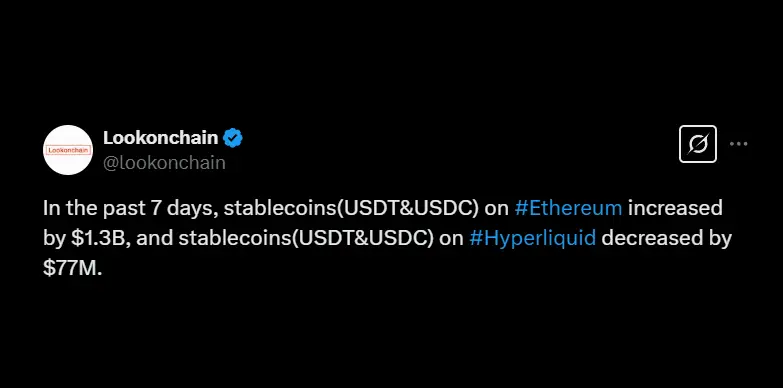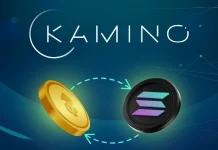
Ethereum, in the past 7 days, has seen a substantial increase of $1.3 billion stablecoin supply (USDT and USDC) according to a data presented by Lookonchain on social media platform X (formerly known as Twitter). This increase strongly indicates a huge capital inflow into the Ethereum ecosystem.

With this increase, it could boost the Ethereum ecosystem in various ways. For example, it could potentially increase DeFi activity, trading volumes or investors seeking stable stores of value.
Hyperliquid Experiences Decrease in contrast to Ethereum
On the contrary, Hyperliquid has experienced a significant drop. On the blockchain, a decrease of $77 million in stablecoin supply has been seen during the same time period. This outflow can be attributed to various factors such as shift in investor sentiment or trading strategies, prompting users to move their stablecoin holdings elsewhere.
Possible explanation for outflow could also include traders seeking higher yields on other platforms, taking profits after a period of activity on Hyperliquid, or concerns about platform-specific risks.
The data provided by Lookonchain, also indicates that the activity on other blockchains has also increased. Solana and Avalanche have seen an increased supply of stablecoins by $347M and $170.57M respectively.

Hyperliquid Faces Challenge to Maintain Liquidity
Hyperliquid faces several challenges in maintaining liquidity, including security concerns that undermine trust, such as past fears of hacking incidents by North Korean hacker group Lazarus, and the risk of being a relatively new protocol with limited liquidity and validator decentralization.
Its reliance on price oracles and a small validator set increases vulnerability to manipulation or systemic risks, while regulatory uncertainty poses additional hurdles in ensuring compliance without sacrificing accessibility.
Moreover, Hyperliquid’s focus on perpetual futures trading makes it highly susceptible to market volatility, which can easily strain liquidity during extreme price movements.
Competing with established platforms like Ethereum also makes it difficult to attract and retain liquidity providers, especially without offering competitive incentives or a proven track record.
Addressing these issues will require strong security measures, enhanced governance, decentralized infrastructure and attractive rewards for liquidity providers to build user confidence.
Also Read: Yescoin Founder Zhang Chi Detained Amid Business Dispute











